service FORD TRANSIT 2016 5.G Owners Manual
[x] Cancel search | Manufacturer: FORD, Model Year: 2016, Model line: TRANSIT, Model: FORD TRANSIT 2016 5.GPages: 411, PDF Size: 5.65 MB
Page 6 of 411
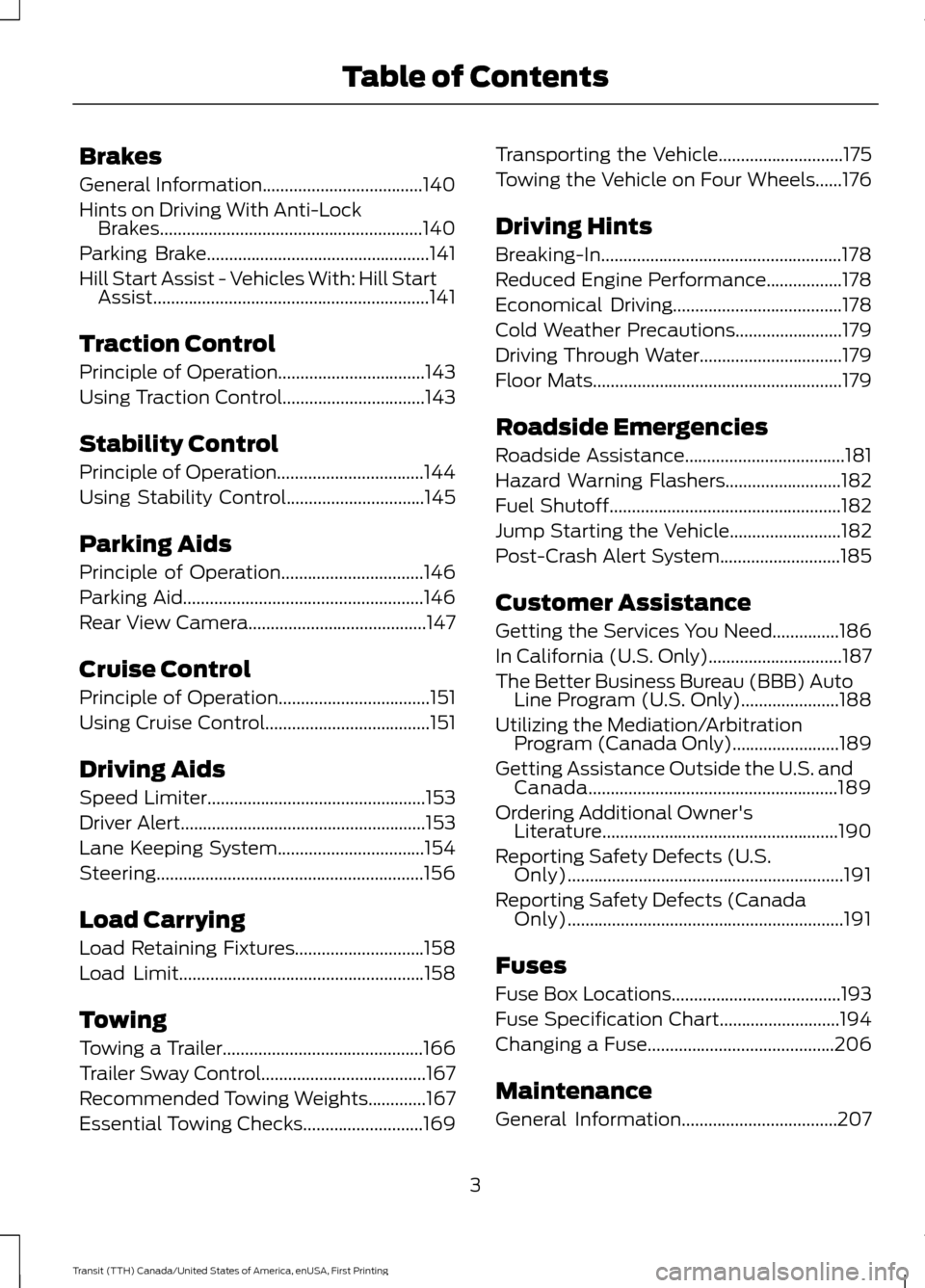
Brakes
General Information....................................140
Hints on Driving With Anti-Lock
Brakes...........................................................140
Parking Brake..................................................141
Hill Start Assist - Vehicles With: Hill Start Assist..............................................................141
Traction Control
Principle of Operation.................................143
Using Traction Control................................143
Stability Control
Principle of Operation.................................144
Using Stability Control...............................145
Parking Aids
Principle of Operation................................146
Parking Aid......................................................146
Rear View Camera........................................147
Cruise Control
Principle of Operation
..................................151
Using Cruise Control.....................................151
Driving Aids
Speed Limiter.................................................153
Driver Alert
.......................................................153
Lane Keeping System.................................154
Steering............................................................156
Load Carrying
Load Retaining Fixtures.............................158
Load Limit
.......................................................158
Towing
Towing a Trailer
.............................................166
Trailer Sway Control.....................................167
Recommended Towing Weights
.............167
Essential Towing Checks...........................169 Transporting the Vehicle
............................175
Towing the Vehicle on Four Wheels......176
Driving Hints
Breaking-In......................................................178
Reduced Engine Performance.................178
Economical Driving
......................................178
Cold Weather Precautions
........................179
Driving Through Water................................179
Floor Mats
........................................................179
Roadside Emergencies
Roadside Assistance
....................................181
Hazard Warning Flashers..........................182
Fuel Shutoff....................................................182
Jump Starting the Vehicle
.........................182
Post-Crash Alert System
...........................185
Customer Assistance
Getting the Services You Need...............186
In California (U.S. Only)
..............................187
The Better Business Bureau (BBB) Auto Line Program (U.S. Only)
......................188
Utilizing the Mediation/Arbitration Program (Canada Only)........................189
Getting Assistance Outside the U.S. and Canada........................................................189
Ordering Additional Owner's Literature.....................................................190
Reporting Safety Defects (U.S. Only)..............................................................191
Reporting Safety Defects (Canada Only)..............................................................191
Fuses
Fuse Box Locations......................................193
Fuse Specification Chart
...........................194
Changing a Fuse..........................................206
Maintenance
General Information...................................207
3
Transit (TTH) Canada/United States of America, enUSA, First Printing Table of Contents
Page 8 of 411
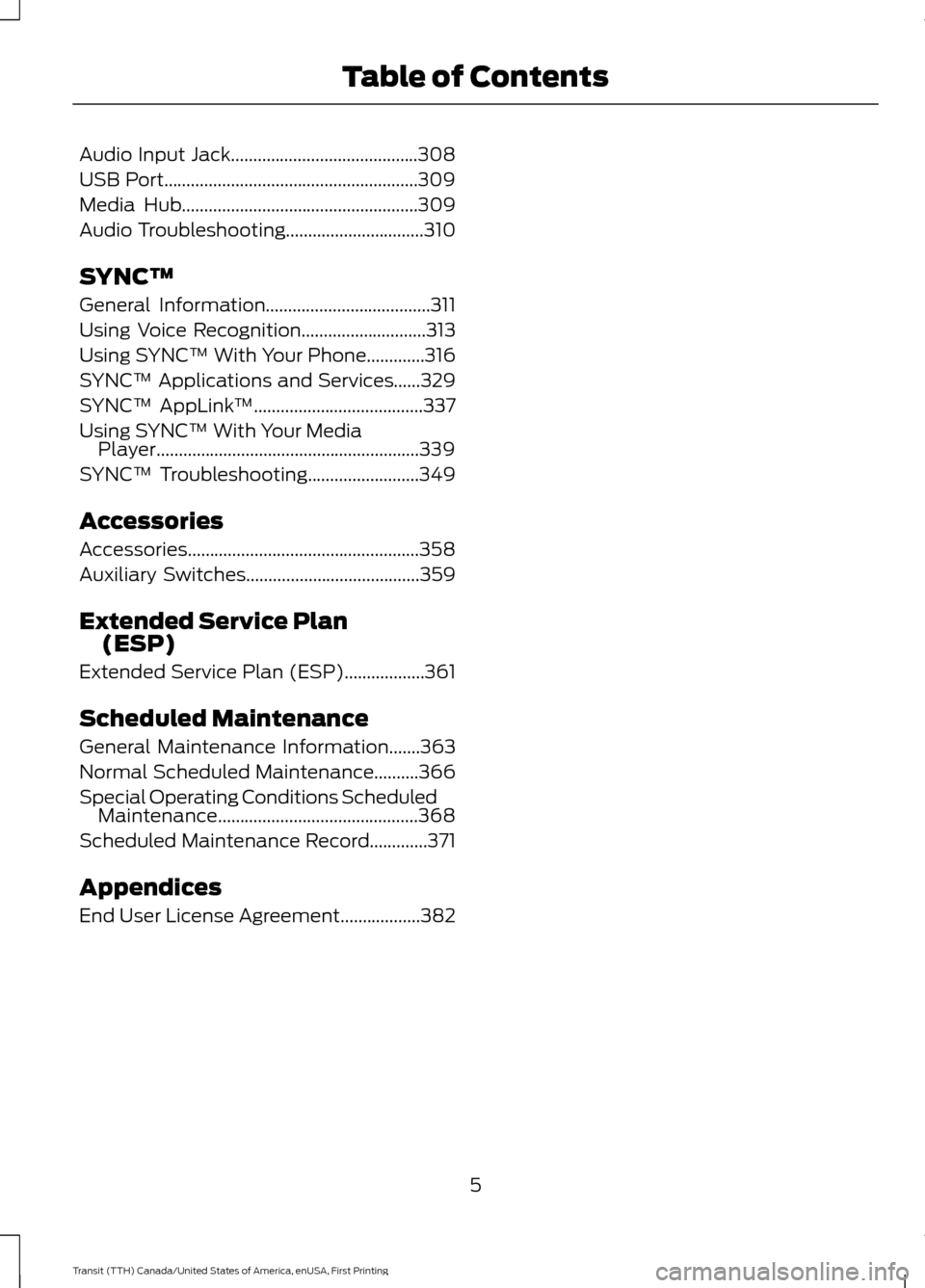
Audio Input Jack..........................................308
USB Port.........................................................309
Media Hub.....................................................309
Audio Troubleshooting
...............................310
SYNC™
General Information.....................................311
Using Voice Recognition............................313
Using SYNC™ With Your Phone.............316
SYNC™ Applications and Services......329
SYNC™ AppLink ™
......................................337
Using SYNC™ With Your Media Player...........................................................339
SYNC™ Troubleshooting.........................349
Accessories
Accessories....................................................358
Auxiliary Switches
.......................................359
Extended Service Plan (ESP)
Extended Service Plan (ESP)..................361
Scheduled Maintenance
General Maintenance Information
.......363
Normal Scheduled Maintenance..........366
Special Operating Conditions Scheduled Maintenance.............................................368
Scheduled Maintenance Record.............371
Appendices
End User License Agreement..................382
5
Transit (TTH) Canada/United States of America, enUSA, First Printing Table of Contents
Page 12 of 411
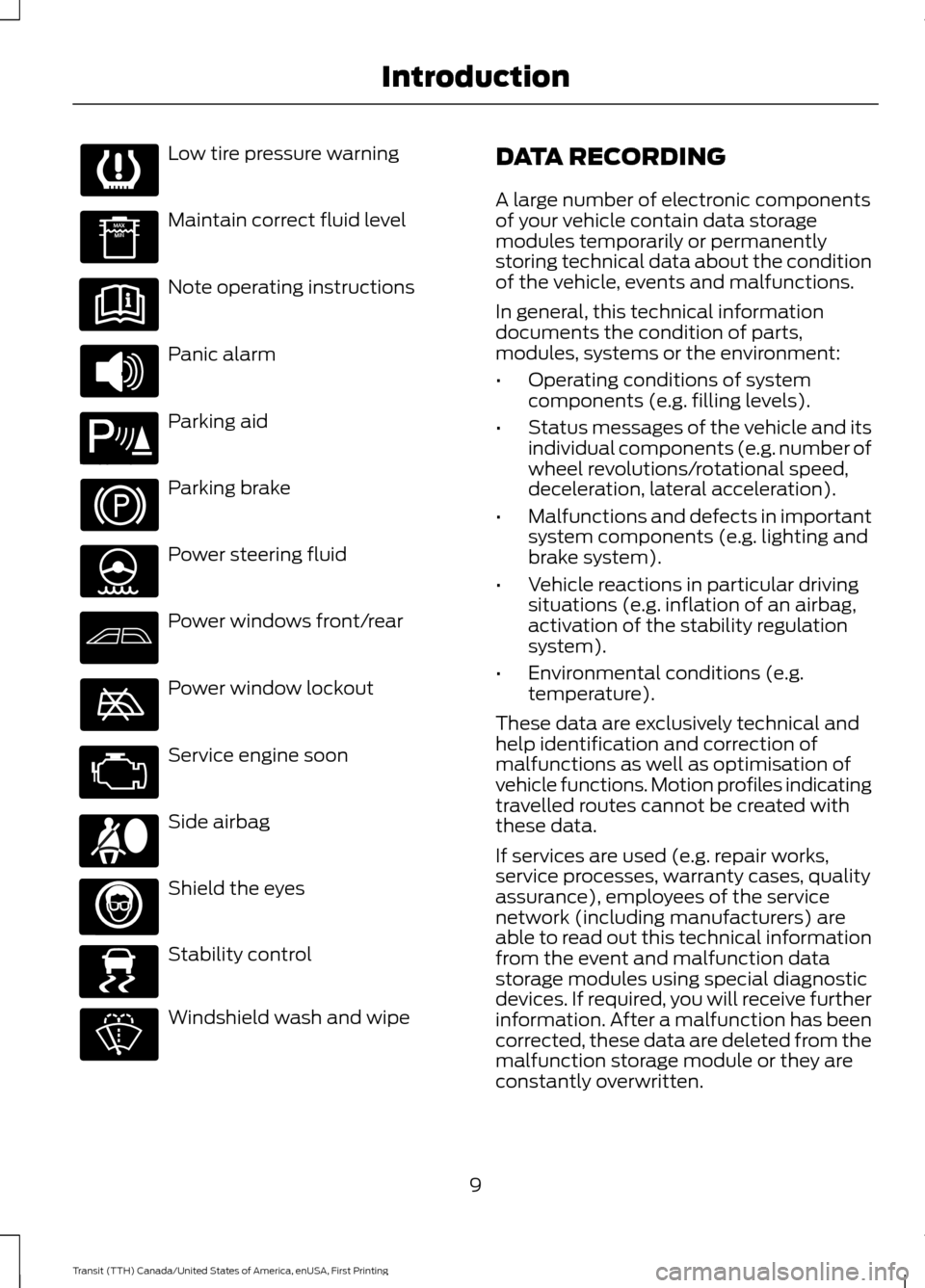
Low tire pressure warning
Maintain correct fluid level
Note operating instructions
Panic alarm
Parking aid
Parking brake
Power steering fluid
Power windows front/rear
Power window lockout
Service engine soon
Side airbag
Shield the eyes
Stability control
Windshield wash and wipe DATA RECORDING
A large number of electronic components
of your vehicle contain data storage
modules temporarily or permanently
storing technical data about the condition
of the vehicle, events and malfunctions.
In general, this technical information
documents the condition of parts,
modules, systems or the environment:
•
Operating conditions of system
components (e.g. filling levels).
• Status messages of the vehicle and its
individual components (e.g. number of
wheel revolutions/rotational speed,
deceleration, lateral acceleration).
• Malfunctions and defects in important
system components (e.g. lighting and
brake system).
• Vehicle reactions in particular driving
situations (e.g. inflation of an airbag,
activation of the stability regulation
system).
• Environmental conditions (e.g.
temperature).
These data are exclusively technical and
help identification and correction of
malfunctions as well as optimisation of
vehicle functions. Motion profiles indicating
travelled routes cannot be created with
these data.
If services are used (e.g. repair works,
service processes, warranty cases, quality
assurance), employees of the service
network (including manufacturers) are
able to read out this technical information
from the event and malfunction data
storage modules using special diagnostic
devices. If required, you will receive further
information. After a malfunction has been
corrected, these data are deleted from the
malfunction storage module or they are
constantly overwritten.
9
Transit (TTH) Canada/United States of America, enUSA, First Printing Introduction E139213 E167012 E138639
Page 13 of 411

When using the vehicle, situations may
occur in which these technical data related
to other information (accident report,
damages on the vehicle, witness
statements, etc.) may be associated with
a specific person - possibly, with the
assistance of an expert.
Additional functions contractually agreed
upon with the client (e.g. vehicle location
in emergency cases) allow the
transmission of particular vehicle data
from the vehicle.
CALIFORNIA PROPOSITION 65
WARNINGS
Some constituents of engine
exhaust, certain vehicle components,
certain fluids contained in vehicles
and certain products of component wear
contain or emit chemicals known to the
State of California to cause cancer and
birth defects or other reproductive harm. Battery posts, terminals and related
accessories contain lead and lead
compounds, chemicals known to the
State of California to cause cancer and
reproductive harm. Batteries also contain
other chemicals known to the State of
California to cause cancer. Wash your
hands after handling. PERCHLORATE
Certain components in your vehicle such
as airbag modules, safety belt
pretensioners and remote control batteries
may contain perchlorate material. Special
handling may apply for service or vehicle
end of life disposal. For more information visit: Web Address
www.dtsc.ca.gov/hazardouswaste/ perchlorate
FORD CREDIT
(U.S. Only)
Ford Credit offers a full range of financing
and lease plans to help you acquire your
vehicle. If you have financed or leased your
vehicle through Ford Credit, thank you for
your business.
For your convenience we offer a number
of ways to contact us, as well as to help
manage your account.
Phone: 1-800-727-7000
For more information regarding Ford Credit,
as well as to access Account Manager,
please go to www.fordcredit.com.
REPLACEMENT PARTS
RECOMMENDATION
Your vehicle has been built to the highest
standards using quality parts. We
recommend that you demand the use of
genuine Ford and Motorcraft parts
whenever your vehicle requires scheduled
maintenance or repair. You can clearly
identify genuine Ford and Motorcraft parts
by looking for the Ford, FoMoCo or
Motorcraft branding on the parts or their
packaging.
10
Transit (TTH) Canada/United States of America, enUSA, First Printing Introduction
Page 14 of 411
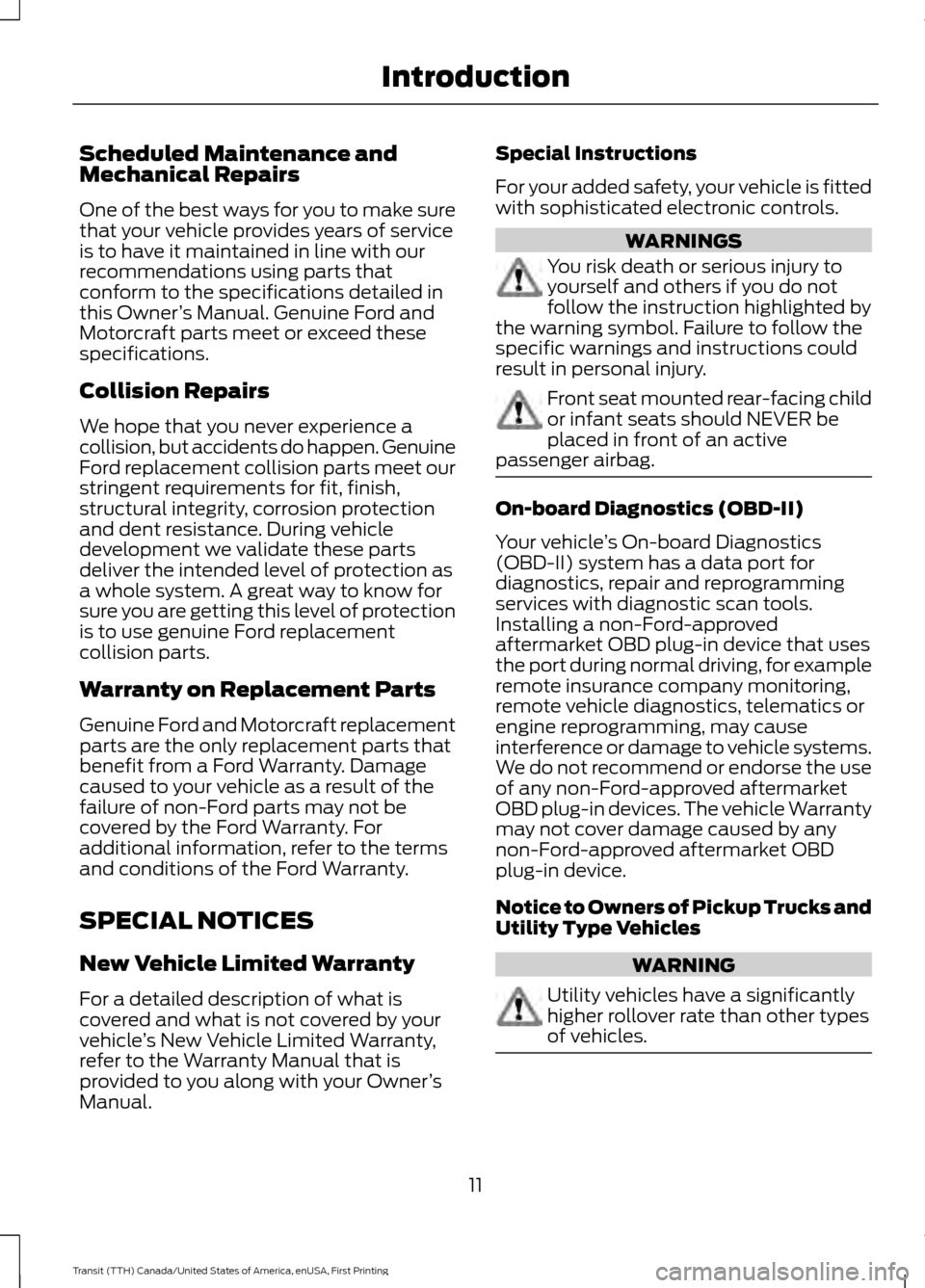
Scheduled Maintenance and
Mechanical Repairs
One of the best ways for you to make sure
that your vehicle provides years of service
is to have it maintained in line with our
recommendations using parts that
conform to the specifications detailed in
this Owner
’s Manual. Genuine Ford and
Motorcraft parts meet or exceed these
specifications.
Collision Repairs
We hope that you never experience a
collision, but accidents do happen. Genuine
Ford replacement collision parts meet our
stringent requirements for fit, finish,
structural integrity, corrosion protection
and dent resistance. During vehicle
development we validate these parts
deliver the intended level of protection as
a whole system. A great way to know for
sure you are getting this level of protection
is to use genuine Ford replacement
collision parts.
Warranty on Replacement Parts
Genuine Ford and Motorcraft replacement
parts are the only replacement parts that
benefit from a Ford Warranty. Damage
caused to your vehicle as a result of the
failure of non-Ford parts may not be
covered by the Ford Warranty. For
additional information, refer to the terms
and conditions of the Ford Warranty.
SPECIAL NOTICES
New Vehicle Limited Warranty
For a detailed description of what is
covered and what is not covered by your
vehicle ’s New Vehicle Limited Warranty,
refer to the Warranty Manual that is
provided to you along with your Owner ’s
Manual. Special Instructions
For your added safety, your vehicle is fitted
with sophisticated electronic controls. WARNINGS
You risk death or serious injury to
yourself and others if you do not
follow the instruction highlighted by
the warning symbol. Failure to follow the
specific warnings and instructions could
result in personal injury. Front seat mounted rear-facing child
or infant seats should NEVER be
placed in front of an active
passenger airbag. On-board Diagnostics (OBD-II)
Your vehicle
’s On-board Diagnostics
(OBD-II) system has a data port for
diagnostics, repair and reprogramming
services with diagnostic scan tools.
Installing a non-Ford-approved
aftermarket OBD plug-in device that uses
the port during normal driving, for example
remote insurance company monitoring,
remote vehicle diagnostics, telematics or
engine reprogramming, may cause
interference or damage to vehicle systems.
We do not recommend or endorse the use
of any non-Ford-approved aftermarket
OBD plug-in devices. The vehicle Warranty
may not cover damage caused by any
non-Ford-approved aftermarket OBD
plug-in device.
Notice to Owners of Pickup Trucks and
Utility Type Vehicles WARNING
Utility vehicles have a significantly
higher rollover rate than other types
of vehicles.
11
Transit (TTH) Canada/United States of America, enUSA, First Printing Introduction
Page 15 of 411
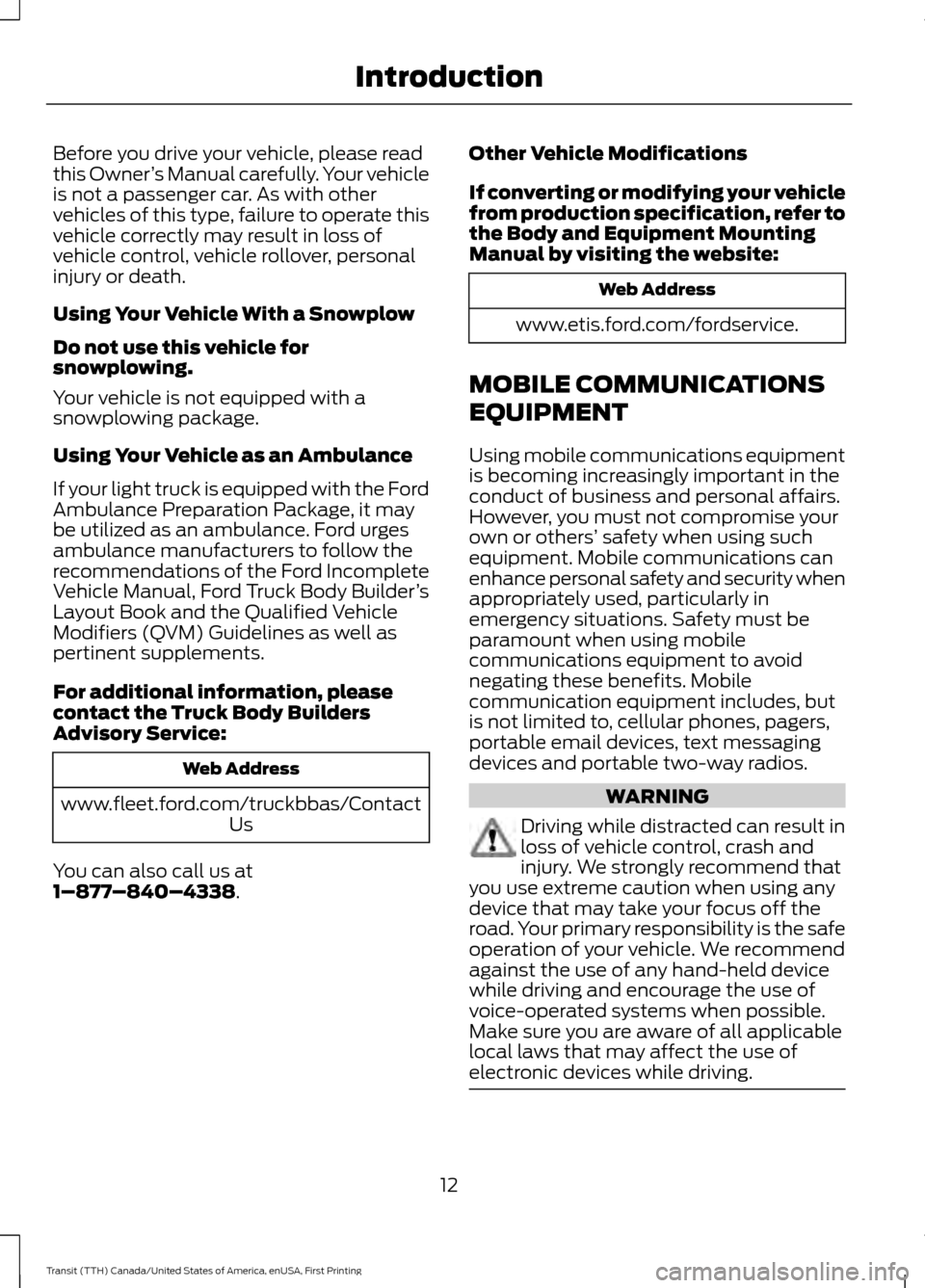
Before you drive your vehicle, please read
this Owner
’s Manual carefully. Your vehicle
is not a passenger car. As with other
vehicles of this type, failure to operate this
vehicle correctly may result in loss of
vehicle control, vehicle rollover, personal
injury or death.
Using Your Vehicle With a Snowplow
Do not use this vehicle for
snowplowing.
Your vehicle is not equipped with a
snowplowing package.
Using Your Vehicle as an Ambulance
If your light truck is equipped with the Ford
Ambulance Preparation Package, it may
be utilized as an ambulance. Ford urges
ambulance manufacturers to follow the
recommendations of the Ford Incomplete
Vehicle Manual, Ford Truck Body Builder ’s
Layout Book and the Qualified Vehicle
Modifiers (QVM) Guidelines as well as
pertinent supplements.
For additional information, please
contact the Truck Body Builders
Advisory Service: Web Address
www.fleet.ford.com/truckbbas/Contact Us
You can also call us at
1–877 –840–4338. Other Vehicle Modifications
If converting or modifying your vehicle
from production specification, refer to
the Body and Equipment Mounting
Manual by visiting the website: Web Address
www.etis.ford.com/fordservice.
MOBILE COMMUNICATIONS
EQUIPMENT
Using mobile communications equipment
is becoming increasingly important in the
conduct of business and personal affairs.
However, you must not compromise your
own or others’ safety when using such
equipment. Mobile communications can
enhance personal safety and security when
appropriately used, particularly in
emergency situations. Safety must be
paramount when using mobile
communications equipment to avoid
negating these benefits. Mobile
communication equipment includes, but
is not limited to, cellular phones, pagers,
portable email devices, text messaging
devices and portable two-way radios. WARNING
Driving while distracted can result in
loss of vehicle control, crash and
injury. We strongly recommend that
you use extreme caution when using any
device that may take your focus off the
road. Your primary responsibility is the safe
operation of your vehicle. We recommend
against the use of any hand-held device
while driving and encourage the use of
voice-operated systems when possible.
Make sure you are aware of all applicable
local laws that may affect the use of
electronic devices while driving. 12
Transit (TTH) Canada/United States of America, enUSA, First Printing Introduction
Page 39 of 411
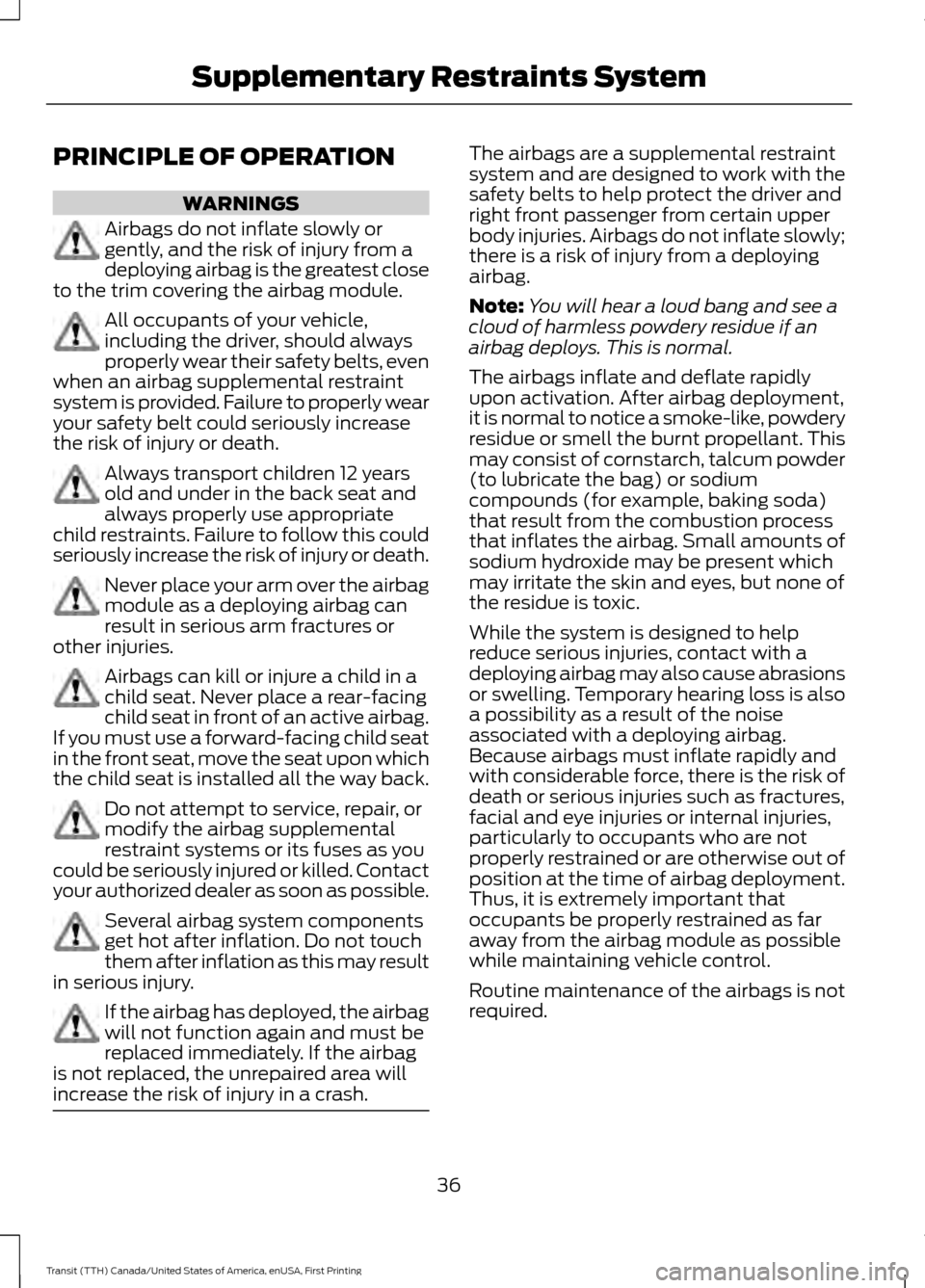
PRINCIPLE OF OPERATION
WARNINGS
Airbags do not inflate slowly or
gently, and the risk of injury from a
deploying airbag is the greatest close
to the trim covering the airbag module. All occupants of your vehicle,
including the driver, should always
properly wear their safety belts, even
when an airbag supplemental restraint
system is provided. Failure to properly wear
your safety belt could seriously increase
the risk of injury or death. Always transport children 12 years
old and under in the back seat and
always properly use appropriate
child restraints. Failure to follow this could
seriously increase the risk of injury or death. Never place your arm over the airbag
module as a deploying airbag can
result in serious arm fractures or
other injuries. Airbags can kill or injure a child in a
child seat. Never place a rear-facing
child seat in front of an active airbag.
If you must use a forward-facing child seat
in the front seat, move the seat upon which
the child seat is installed all the way back. Do not attempt to service, repair, or
modify the airbag supplemental
restraint systems or its fuses as you
could be seriously injured or killed. Contact
your authorized dealer as soon as possible. Several airbag system components
get hot after inflation. Do not touch
them after inflation as this may result
in serious injury. If the airbag has deployed, the airbag
will not function again and must be
replaced immediately. If the airbag
is not replaced, the unrepaired area will
increase the risk of injury in a crash. The airbags are a supplemental restraint
system and are designed to work with the
safety belts to help protect the driver and
right front passenger from certain upper
body injuries. Airbags do not inflate slowly;
there is a risk of injury from a deploying
airbag.
Note:
You will hear a loud bang and see a
cloud of harmless powdery residue if an
airbag deploys. This is normal.
The airbags inflate and deflate rapidly
upon activation. After airbag deployment,
it is normal to notice a smoke-like, powdery
residue or smell the burnt propellant. This
may consist of cornstarch, talcum powder
(to lubricate the bag) or sodium
compounds (for example, baking soda)
that result from the combustion process
that inflates the airbag. Small amounts of
sodium hydroxide may be present which
may irritate the skin and eyes, but none of
the residue is toxic.
While the system is designed to help
reduce serious injuries, contact with a
deploying airbag may also cause abrasions
or swelling. Temporary hearing loss is also
a possibility as a result of the noise
associated with a deploying airbag.
Because airbags must inflate rapidly and
with considerable force, there is the risk of
death or serious injuries such as fractures,
facial and eye injuries or internal injuries,
particularly to occupants who are not
properly restrained or are otherwise out of
position at the time of airbag deployment.
Thus, it is extremely important that
occupants be properly restrained as far
away from the airbag module as possible
while maintaining vehicle control.
Routine maintenance of the airbags is not
required.
36
Transit (TTH) Canada/United States of America, enUSA, First Printing Supplementary Restraints System
Page 41 of 411

Note:
The passenger airbag status indicator
OFF and ON lamps illuminate for a short
period of time when you switch the ignition
on to confirm it is functional. Passenger airbag
Passenger airbag status
indicator
Switch position
Disabled
OFF: Lit
Off
ON: Unlit Enabled
OFF: Unlit
On
ON: LitLow-series vehicles (if equipped)
The front passenger airbag on and off
switch has an indicator that illuminates
and stays lit to remind you that the front
passenger frontal airbag is off. The
indicator lamp is located by the radio.
Note:
The indicator lamp will illuminate for
a short period of time when the ignition is
first turned on to confirm it is functional.
Turning the Passenger Airbag Off WARNINGS
If the light fails to illuminate when
the passenger airbag switch is off
and the ignition is on, have the
passenger airbag switch serviced at your
authorized dealer immediately. In order to avoid inadvertent
activation of the switch, always
remove the ignition key from the
passenger airbag on and off switch. WARNINGS
An infant in a rear-facing seat faces
a high risk of serious or fatal injuries
from a deploying passenger airbag.
Rear facing infant seats should never be
placed in the front seats, unless the
passenger airbag is turned off. 38
Transit (TTH) Canada/United States of America, enUSA, First Printing Supplementary Restraints SystemE170613
Page 42 of 411
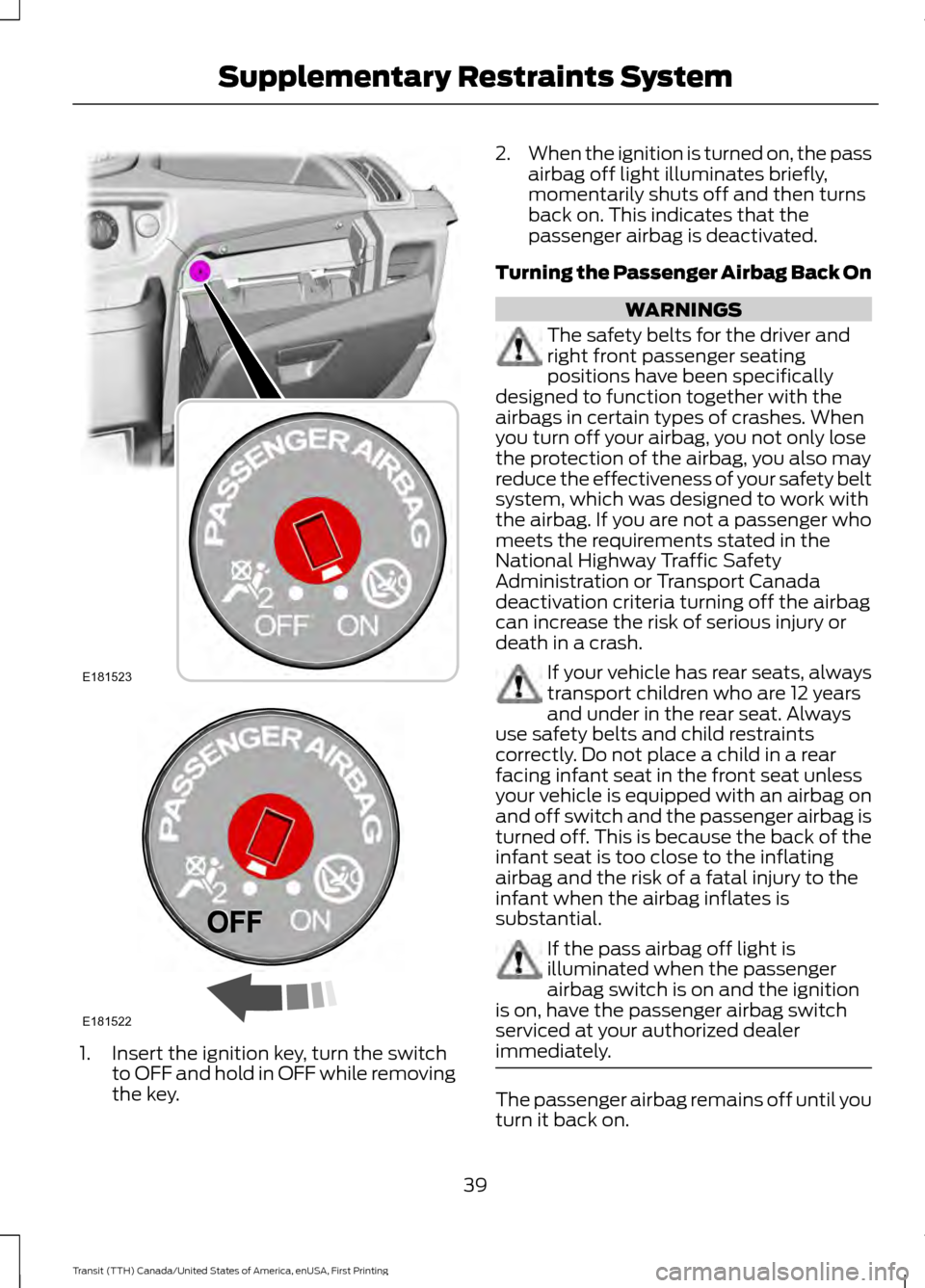
1. Insert the ignition key, turn the switch
to OFF and hold in OFF while removing
the key. 2.
When the ignition is turned on, the pass
airbag off light illuminates briefly,
momentarily shuts off and then turns
back on. This indicates that the
passenger airbag is deactivated.
Turning the Passenger Airbag Back On WARNINGS
The safety belts for the driver and
right front passenger seating
positions have been specifically
designed to function together with the
airbags in certain types of crashes. When
you turn off your airbag, you not only lose
the protection of the airbag, you also may
reduce the effectiveness of your safety belt
system, which was designed to work with
the airbag. If you are not a passenger who
meets the requirements stated in the
National Highway Traffic Safety
Administration or Transport Canada
deactivation criteria turning off the airbag
can increase the risk of serious injury or
death in a crash. If your vehicle has rear seats, always
transport children who are 12 years
and under in the rear seat. Always
use safety belts and child restraints
correctly. Do not place a child in a rear
facing infant seat in the front seat unless
your vehicle is equipped with an airbag on
and off switch and the passenger airbag is
turned off. This is because the back of the
infant seat is too close to the inflating
airbag and the risk of a fatal injury to the
infant when the airbag inflates is
substantial. If the pass airbag off light is
illuminated when the passenger
airbag switch is on and the ignition
is on, have the passenger airbag switch
serviced at your authorized dealer
immediately. The passenger airbag remains off until you
turn it back on.
39
Transit (TTH) Canada/United States of America, enUSA, First Printing Supplementary Restraints SystemE181523 E181522
Page 46 of 411

SIDE AIRBAGS (If Equipped)
WARNINGS
Do not place objects or mount
equipment on or near the airbag
cover, on the side of the seatbacks
(of the front seats), or in front seat areas
that may come into contact with a
deploying airbag. Failure to follow these
instructions may increase the risk of
personal injury in the event of a crash. Do not use accessory seat covers.
The use of accessory seat covers
may prevent the deployment of the
side airbags and increase the risk of injury
in an accident. Do not lean your head on the door.
The side airbag could injure you as it
deploys from the side of the
seatback. Do not attempt to service, repair, or
modify the airbag, its fuses or the
seat cover on a seat containing an
airbag as you could be seriously injured or
killed. Contact your authorized dealer as
soon as possible. If the side airbag has deployed, the
airbag will not function again. The
side airbag system (including the
seat) must be inspected and serviced by
an authorized dealer. If the airbag is not
replaced, the unrepaired area will increase
the risk of injury in a crash. The side airbags are located on the
outboard side of the seatbacks of the front
seats. In certain sideways crashes, the
airbag on the side affected by the crash
will be inflated. The airbag was designed
to inflate between the door panel and
occupant to further enhance the protection
provided occupants in side impact crashes. The system consists of the following:
•
A label or embossed side panel
indicating that side airbags are found
on your vehicle.
• Side airbags located inside the
seatback of the driver and front
passenger seats. ·Crash sensors and monitoring
system with readiness indicator.
See Crash Sensors and Airbag
Indicator
(page 45).
The design and development of the side
airbag system included recommended
testing procedures that were developed
by a group of automotive safety experts
known as the Side Airbag Technical
Working Group. These recommended
testing procedures help reduce the risk of
injuries related to the deployment of side
airbags.
SAFETY CANOPY™
(If Equipped) WARNINGS
Do not place objects or mount
equipment on or near the headliner
at the side rail that may come into
contact with a deploying curtain airbag.
Failure to follow these instructions may
increase the risk of personal injury in the
event of a crash.
43
Transit (TTH) Canada/United States of America, enUSA, First Printing Supplementary Restraints SystemE152533